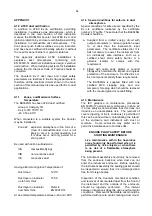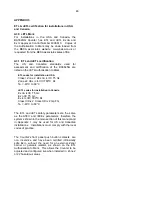
10.3.6 Setpoint adjustment:
5P1
x &
5P2
x
The rate alarm setpoints SP1r and SP2r may be
positioned anywhere between 000000 and 999999,
and the total alarm setpoint SP1t and SP2t anywhere
between 00000000 and 99999999.
All the setpoints are adjusted in the same way, for
example, to adjust the setpoint of Alarm 1 which has
been configured to operate on the rate display.
Using the
&
or
*
push button select
5P1r
in the
AL1 sub-menu and press
(
which will reveal the
existing setpoint with one digit flashing. The required
setpoint can be entered using the
&
or
*
push
button to adjust the flashing digit and the
(
button to
transfer control to the next digit. When set as
required press
)
to enter the value and return to the
5P1r
prompt in the alarm 1 sub-menu.
10.3.7 Alarm function:
Hi.
Lo
Alarm 1 and Alarm 2 are totally independent, both
may be Hi or Lo, or one may be conditioned as a Hi
alarm and the other as a Lo alarm.
Using the
&
or
*
push button select
Hi.
Lo
from the
selected alarm sub-menu and press
(
to check or
change the function. The
&
or
*
push button will
toggle the alarm function between
Hi
and
Lo
, when
set as required, press the
)
button to return to the
Hi.
Lo
prompt in the alarm sub-menu.
10.3.8 Alarm output status:
no
.
nC
Each single pole alarm output may be open or closed
in the non-alarm condition. When the BA364NG
power supply is turned off or disconnected, the alarm
output(s) will open irrespective of whether normally
open or normally closed outputs have been selected.
Therefore, when designing an alarm system normally
closed
nc
should be selected so that the output opens
when an alarm occurs or if the power supply fails.
Using the
&
or
*
push button select
no
.
nC
from the
selected alarm sub-menu and press
(
to check or
change the function. The
&
or
*
push button will
toggle the contact status between
no
and
nC
, when
set as required, press the
)
button to return to the
no
.
nC
prompt in the alarm sub-menu
10.3.9 Hysteresis:
H5tr
Hysteresis is only available on rate alarms so the
H5tr
function only appears in the configuration sub-
menu when alarm
tYPE
has been set to
rAtE
. During
configuration hysteresis is shown in the units of rate
previously configured for the rate display.
Using the
&
or
*
push button select
H5tr
in the
selected alarm sub-menu and press
(
which will
reveal the existing hysteresis with one digit flashing.
The required hysteresis can be entered using the
&
or
*
push button to adjust the flashing digit and the
(
button to transfer control to the next digit. When
set as required press
)
to enter the value and
return to the
H5tr
prompt in the alarm sub-menu.
e.g. A BA364NG Counter configured to display a
rate of 0 to 5000, with a high alarm set at 4000 and
hysteresis of 100 will perform as follows:
High alarm will be activated when rate
equals or exceeds 4000, but will not reset
until the rate falls below 3900.
10.3.10 Alarm delay:
dELA
This function enables activation of the alarm output
to be delayed for a fixed time following the alarm
condition occurring. The delay can be set in 1
second increments up to 3600 seconds. If a delay
is not required zero should be entered.
To adjust the delay select
dELA
using the
&
or
*
push button in the selected alarm sub-menu and
press
(
which will reveal the existing delay time
in seconds with one digit flashing. The required
delay time can be entered using the
&
or
*
push button to adjust the flashing digit and the
(
button to transfer control to the next digit.
When set as required press
)
to enter the value
and return to the
dELA
prompt in the alarm sub-
menu.
The alarm annunciator will start flashing
immediately an alarm condition occurs and will
continue for the delay time, after which the alarm
output will be activated and the alarm annunciator
will be permanently activated.
10.3.11 Alarm silence time:
5IL
The alarm silence function is primarily intended for
use in small installations where the alarm output
directly operates an annunciator such as a
sounder. When the alarm silence time is set to any
figure other than zero, the
(
push button
becomes an alarm accept button.
After an alarm has occurred, operating the
(
button will cause the alarm output to revert to
the non-alarm condition for the alarm silence time.
When an alarm is silenced the alarm annunciator
will flash until the silence time expires.
To adjust the alarm silence time select
5iL
using
the
&
or
*
push button in the selected alarm
sub-menu and press
(
which will reveal the
existing alarm silence time in seconds with one
digit flashing. The required silence time can be
entered using the
&
or
*
push button to adjust
the flashing digit and the
(
button to transfer
control to the next digit. When set as required
press
)
to enter the value and return to the
5iL
prompt in the alarm sub-menu.
39
Summary of Contents for BA364NG
Page 1: ...Issue 6 9th July 2019 BA364NG Two Input Ex nA and Ex tc Counter Issue 6 ...
Page 4: ...4 ...
Page 18: ...18 ...
Page 19: ...19 ...








































